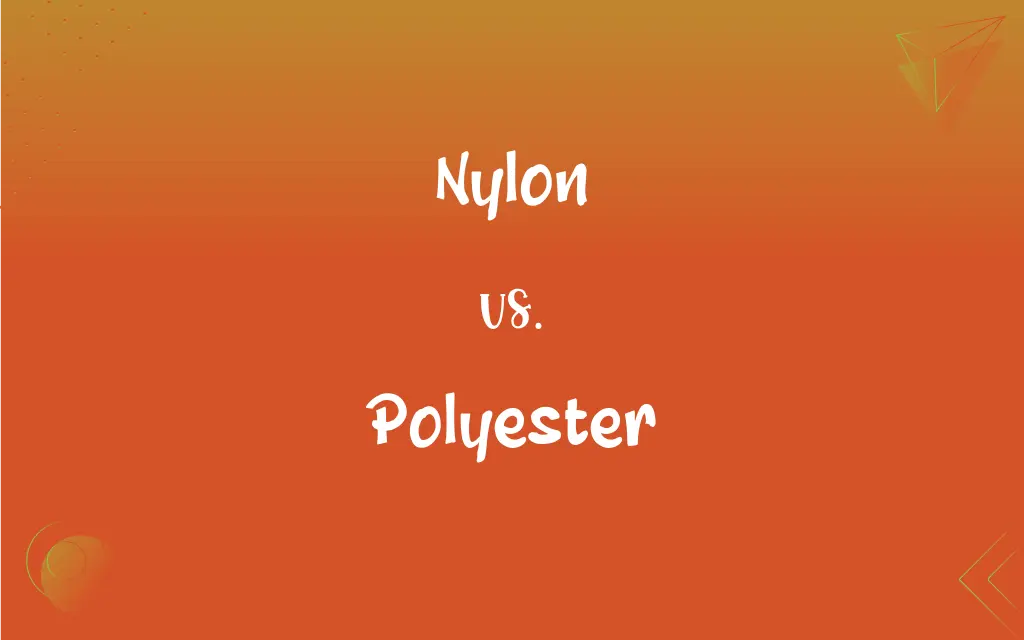Nylon vs. Polyester: What's the Difference?
Edited by Aimie Carlson || By Harlon Moss || Updated on October 16, 2023
Nylon is a synthetic polymer derived from petrochemicals, while polyester is made from esterified polymer derived from petrochemicals or plant-based sources.

Key Differences
Nylon and polyester are both synthetic fibers, but they originate from different raw materials. Nylon is primarily made from petrochemicals, while polyester can be derived from petrochemicals or plant-based resources.
Nylon is known for its resilience and elasticity, making it ideal for products like hosiery and ropes. Polyester, on the other hand, is more resistant to UV rays and moisture, making it suitable for outdoor clothing and furnishings.
In terms of environmental impact, nylon production is often more energy-intensive and has a larger carbon footprint. Polyester, especially when made from recycled materials, tends to be more eco-friendly in comparison.
When discussing moisture management, nylon tends to absorb more moisture than polyester, which wicks away moisture and dries faster.
Finally, in the realm of durability, both nylon and polyester are strong, but nylon often has a softer feel, while polyester holds its shape better over time.
ADVERTISEMENT
Comparison Chart
Origin
Derived from petrochemicals.
Derived from petrochemicals or plants.
Resilience
High elasticity and resilience.
Resists UV rays and moisture better.
Environmental Impact
More energy-intensive production.
Often more eco-friendly.
Moisture Management
Absorbs more moisture.
Wicks moisture and dries faster.
Feel & Durability
Softer feel but may pill.
Holds shape better over time.
ADVERTISEMENT
Nylon and Polyester Definitions
Nylon
A synthetic polymer derived from petrochemicals.
The bag was made from durable nylon.
Polyester
Commonly used in outdoor clothing and furnishings.
The polyester canopy provided shade during the sunny day.
Nylon
Known for its elasticity and resilience.
Her nylon stockings resisted runs.
Polyester
Known for its resistance to wrinkles and shrinking.
His polyester shirt remained wrinkle-free all day.
Nylon
Commonly used in ropes due to its strength.
The climbers trusted the nylon rope to support their weight.
Polyester
A synthetic fiber derived from esterified polymer.
The jacket was made of 100% polyester.
Nylon
Frequently used in textiles and fabrics.
The tent's nylon material kept us dry during the rain.
Polyester
Often blended with other fibers for enhanced properties.
The polyester-cotton blend made the shirt both soft and durable.
Nylon
Has a higher moisture absorption than polyester.
The nylon shirt felt damp after the workout.
Polyester
Has low moisture absorption and dries quickly.
After the rain, her polyester jacket dried in no time.
Nylon
Any of a family of high-strength, resilient synthetic polymers, the molecules of which contain the recurring amide group CONH.
Polyester
Any of numerous synthetic polymers produced chiefly by reaction of dicarboxylic acids with dihydric alcohols and used primarily as light, strong, weather-resistant resins in boat hulls, textile fibers, adhesives, and molded parts.
Nylon
Cloth or yarn made from one of these synthetic materials.
Polyester
A wrinkle-resistant fabric of fibers made from any of these resins.
FAQs
Which is more elastic, nylon or polyester?
Nylon is known for its elasticity and resilience.
Which is better for outdoor use, nylon or polyester?
Polyester is more resistant to UV rays and moisture, making it better for outdoor use.
Which fabric tends to absorb more moisture?
Nylon tends to absorb more moisture than polyester.
Which fabric is more prone to pilling, nylon or polyester?
Nylon may be more prone to pilling than polyester.
What is polyester made from?
Polyester is made from esterified polymer derived from petrochemicals or plant-based sources.
Can both nylon and polyester be recycled?
Yes, both nylon and polyester can be recycled, though the processes differ.
Which material dries faster?
Polyester tends to dry faster than nylon.
Which fabric is better for swimwear?
Both can be used, but nylon is often favored for its softness and fit.
Why is nylon used in ropes and parachutes?
Due to its strength and elasticity, nylon is a popular choice for ropes and parachutes.
Which material is generally more affordable?
Polyester is often less expensive than nylon, but prices can vary based on other factors.
Which is more wrinkle-resistant?
Polyester is more wrinkle-resistant than nylon.
Is polyester suitable for sensitive skin?
Some people with sensitive skin might find polyester less comfortable than natural fibers.
Is polyester flame resistant?
Polyester has a higher melting point than some other fabrics, but it is not inherently flame-resistant.
What is nylon made from?
Nylon is a synthetic polymer derived from petrochemicals.
How does the environmental impact of nylon compare to polyester?
Nylon production is often more energy-intensive, while polyester, especially from recycled materials, tends to be more eco-friendly.
Which material is softer to the touch?
Nylon often has a softer feel compared to polyester.
Is polyester good for winter wear?
Polyester is good at retaining heat, making it suitable for winter wear.
Are there eco-friendly versions of both fabrics?
Yes, there are eco-friendly versions of both nylon and polyester, such as recycled nylon and recycled polyester.
How do I care for nylon garments?
Nylon should be washed in cold water and air-dried to prevent shrinking or melting.
How do I care for polyester garments?
Polyester is durable and can usually be machine-washed and tumble dried.
About Author
Written by
Harlon MossHarlon is a seasoned quality moderator and accomplished content writer for Difference Wiki. An alumnus of the prestigious University of California, he earned his degree in Computer Science. Leveraging his academic background, Harlon brings a meticulous and informed perspective to his work, ensuring content accuracy and excellence.
Edited by
Aimie CarlsonAimie Carlson, holding a master's degree in English literature, is a fervent English language enthusiast. She lends her writing talents to Difference Wiki, a prominent website that specializes in comparisons, offering readers insightful analyses that both captivate and inform.































































